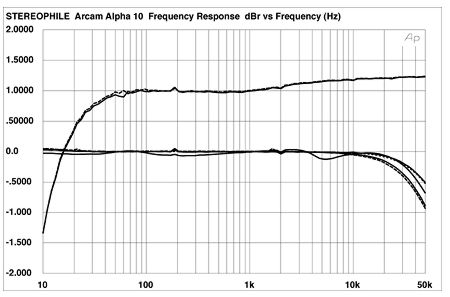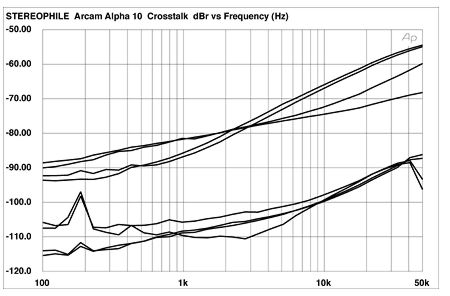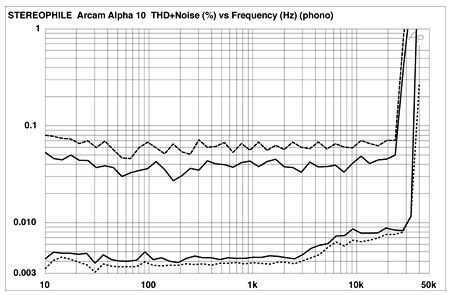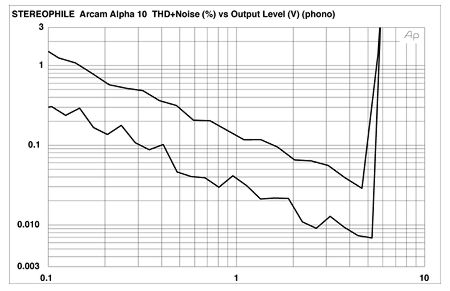| Columns Retired Columns & Blogs |
Arcam Alpha 10 integrated amplifier & Alpha 10P power amplifier Measurements
Sidebar 3: Measurements
Footnote 1: There seems to be a split developing in the amplifier world, where some British designs like these Arcams and the Creek 4430R are optimized to deliver high power into low-impedance loads on tonebursts, behaving like voltage sources, while other high-end amplifiers, like the Bow Wazoo reviewed elsewhere in this issue, are more like current sources.—John Atkinson
Both the Arcam Alpha 10 integrated amplifier and 10P power amplifier are discussed in this section. The power amplifier in the 10P is virtually identical to that in the 10; the few minor differences found on the test bench are noted here.
Both amplifiers shut down about 30 minutes into their one-hour, 1/3-power preconditioning test, after running relatively hot but not alarmingly so. The protection circuits of both appear to be very sensitive; I ran into delays a number of times at the test bench when the amplifiers shut down. Each amp's heatsinks seem rather small for the power rating. However, I would not expect this to be a problem with typical program material—as contrasted with steady-state test-bench inputs.
The Alpha 10 integrated's line input impedance measured 14k ohms and was constant with changes in the level control. The volume-control tracking was excellent. The output impedance is comfortably low—under 0.06 ohms up to 1kHz, rising to a maximum of 0.16 ohms at 20kHz. The output impedance at the tape outputs measured 47 ohms with either a 25 ohm or 600 ohm source impedance, indicating buffered tape outputs. The output impedance at the preamp outputs also measured 47 ohms. The voltage gain of the Alpha integrated with the level control set at maximum is 45.7dB.
DC offset at the main outputs of the Arcam integrated amplifier measured a low 1.7mV in the left channel, 2.0mV in the right. Signal/Noise (ref. 1W into 8 ohms), with the level control set at a position that produced an overall line gain of 34.75dB (approximately 75% of maximum), measured 74dB from 22Hz to 22kHz and 63dB from 10Hz to 500kHz, both unweighted, and 76dB A-weighted. (All values are to the nearest dB.) The corresponding values at the full setting of the level control are 75dB, 65dB, and 76dB, respectively. The Arcam integrated is noninverting from either its line or phono inputs, a positive-going input resulting in a positive-going output.
The Arcam integrated's phono stage was measured from the tape outputs, in both its moving-coil and moving-magnet modes. The MC gain is 55.7dB (MM: 35.9dB), the MC input impedance 313 ohms (MM: 46.8k ohms). Phono S/N (ref. 1V) for the MC input measured a high 82dB from 22Hz to 22kHz, 78dB from 10Hz to 500kHz, and 86dB unweighted. (Corresponding MM values: 89dB, 82dB, and 94dB.) Phono overload with an unequalized input for MC measured 9.82mV at 1kHz (25.9dB), 77mV at 20kHz (23.8dB), and 1.15mV at 20Hz (27.2dB). The corresponding values for the MM input are 90.1mV (25.1dB) at 1kHz, 845mV (24.6dB) at 20kHz, and 10.22mV (26.2dB) at 20Hz. All of these are excellent figures.
The Alpha 10P power amp had a measured voltage gain of 31.5dB into 8 ohms. Its DC offset measured 4mV in the left channel, 0.5mV in the right. Its input impedance is 32.2k ohms usefully higher than specified), and its output impedance is very slightly (ie, insignificantly) lower than that of the 10 integrated. Like the Alpha integrated, the 10P is noninverting.
In the following results, the measurements of the Alpha integrated amplifier's line stages were taken primarily at a volume-control setting that resulted in a gain of 34.75dB at an input of 100mV. (This was the closest it was possible to get to a setting of 34dB with the stepped volume control. This level was chosen because it is representative of the maximum gain from a typical power amp/preamp combination when the preamp has a modest gain of 6dB.) The measurements for THD+noise percentage vs frequency and crosstalk were made on the Alpha 10 integrated's phono stage using input levels that resulted in the minimum contribution from noise. These levels are the minimums indicated in fig.10.
Fig.1 shows the Alpha 10P's frequency response. The line-level frequency response of the 10, not shown here, is virtually identical. Also plotted in fig.1, offset by +1dB for clarity, is the RIAA response of the phono stage of the 10. The rise in the high frequencies, which extends over most of the treble range, might result in a slight added sparkle, but at 0.25dB the effect will probably be inaudible in most systems.

Fig.1 Arcam Alpha 10, frequency response at (from top to bottom): MC input; 1W into 8 ohms; 2.828V into simulated loudspeaker load (bottom at 5kHz); 2W into 4 ohms (0.5dB/vertical div., right channel dashed.)
Fig.2 indicates the Arcam integrated's output with a 10kHz squarewave input, a solid result with a respectably fast risetime and only a slight rounding of the leading edge of the waveform. The Arcam's 1kHz squarewave response, not shown, is of near-textbook quality. (The result for the virtually identical 10P power amp is not shown.)

Fig.2 Arcam Alpha 10, small-signal 10kHz squarewave into 8 ohms.
Fig.3 shows the channel separation for both the 10 and the 10P: a good though not exceptional result for the line stages, though a better one for the phono inputs. The increase in crosstalk at higher frequencies is not uncommon and is generally due to capacitive coupling from one channel to the other.

Fig.3 Arcam Alpha 10, crosstalk (from top to bottom at 10kHz): R-L, line, integrated; R-L, power; L-R, line, integrated; L-R, power; R-L, MM, integrated (tape out); L-R, MM, integrated (tape out); R-L, MC, integrated (tape out); L-R, MC, integrated (tape out) (10dB/vertical div.).
The THD+noise percentage vs frequency results are shown in figs.4-6. The integrated amplifier has slightly higher distortion than the power amp alone, though the differences are much smaller at high frequencies. The MC phono stage also has higher distortion than the MM—not an unexpected outcome. Fig.7 shows the THD+noise output waveform of the Arcam with a 1kHz input at 10W into a 4 ohm load. The result is a noisy third harmonic with evidence of higher harmonics also present.

Fig.4 Arcam Alpha 10P, THD+noise vs frequency at (from top to bottom at 10kHz): 4W into 2 ohms, 2W into 4 ohms, 2.83V into simulated loudspeaker load, and 1W into 8 ohms (right channel dashed).

Fig.5 Arcam Alpha 10, THD+noise vs frequency at (from top to bottom at 10kHz): 4W into 2 ohms, 2W into 4 ohms, 2.83V into simulated loudspeaker load, and 1W into 8 ohms (right channel dashed).

Fig.6 Arcam Alpha 10, phono input, THD+noise vs frequency (from top to bottom at 1kHz): MC, MM (right channel dashed).

Fig.7 Arcam Alpha 10, 1kHz waveform at 10W into 4 ohms (top), distortion and noise waveform with fundamental notched out (bottom, not to scale).
Fig.8 shows the Arcam 10P's output spectrum to a 50Hz input at an output of 120W into a 4 ohm load. All of the artifacts here are below -90dB (0.003%). The intermodulation in the output caused by a combined 19+20kHz at 103W into 4 ohms is shown in fig.9. Most of the artifacts with this input are below -80dB (0.01%); slightly larger artifacts can be seen at 15kHz, 17kHz, and 18kHz, with the largest at 17kHz (-73.4dB, or about 0.02%). These results are good for an amplifier in this power and price class; they're even better at 8 ohms (64W), not shown, where the artifacts are cleaner, with no power-supply-related sidebands. The corresponding 50Hz and 19+20kHz spectrum measurements for the identical power-amp stage in the Alpha integrated are not shown here. While they differ somewhat from those of the 10P, the results are still good and do not indicate any significant differences between the amplifiers.

Fig.8 Arcam Alpha 10P, output spectrum, DC-1kHz, 50Hz at 120W into 4 ohms (linear frequency scale).

Fig.9 Arcam Alpha 10P, HF intermodulation spectrum, DC-22kHz, 19+20kHz at 103W into 4 ohms (linear frequency scale).
Fig.10 shows the THD+noise vs output voltage curves for the Alpha 10 integrated's phono inputs. Fig.11 shows the same measurement for the Alpha 10P power amplifier, one channel driven at 1kHz. The discrete clipping measurements for the Alpha 10 (1% THD+noise at 1kHz), to the nearest watt, are shown in Table 1. Note that in fig.11 the amplifier's protection circuit shut down during the 2 ohm test. Discrete measurements were therefore not taken for this load.

Fig.10 Arcam Alpha 10, phono stage, distortion (%) vs output voltage (V) (from bottom to top): MC, MM.

Fig.11 Arcam Alpha 10P, distortion (%) vs continuous output power (W) into (from bottom to top): 8 ohms, 4 ohms, and 2 ohms (one channel driven).
Table 1: Arcam Alpha 10, Maximum Continuous Output Power (1% THD+N)
| Both Channels Driven | One Channel Driven | ||
| W (dBW) | W (dBW) | ||
| Load | (L) | (R) | (L) |
| 8 ohms | 115.1 (20.6) | 115.9 (20.6) | 131.4 (21.2) |
| (line V) | 119V | 119V | 119V |
| 4 ohms | 165.9 (19.2) | 168.3 (19.3) | 206.5 (20.1) |
| (line V) | 118V | 118V | 119V |
John Atkinson measured the Arcam 10P's dynamic output power using the Miller Audio Research Amplifier Profiler and a 1kHz toneburst with a low duty cycle to approximate the behavior of the amplifier on music. The results are shown in fig.12. With this kind of signal, the Arcam is a powerhouse, delivering significantly more power (footnote 1). Into 8 ohms, for example, it gives 155.8W compared with 115.1W on a continuous basis. The 4 ohm burst power was 271.5W and into 2 ohms, 419.1W was available. Only into the punishing 1 ohm load, where the 1% THD limit was reached at 425W, did the power supply voltage droop to the point where no more significant power was available. But the peak current at this point was an astonishing 20.6A!

Fig.12 Arcam Alpha 10, distortion (dB) vs dynamic output power into 8 ohms (black), 4 ohms (red), 2 ohms (blue), and 1 ohm (green) (one channel driven).
The Arcam Alpha 10 and 10P measured well on the test bench. The amplifiers are not really designed for very low impedance loads, and, given their limited heatsinking, are probably not the best choices for driving difficult loads. But while they are not over-engineered, they should provide fine performance in more typical systems.—Thomas J. Norton
Footnote 1: There seems to be a split developing in the amplifier world, where some British designs like these Arcams and the Creek 4430R are optimized to deliver high power into low-impedance loads on tonebursts, behaving like voltage sources, while other high-end amplifiers, like the Bow Wazoo reviewed elsewhere in this issue, are more like current sources.—John Atkinson
- Log in or register to post comments




































